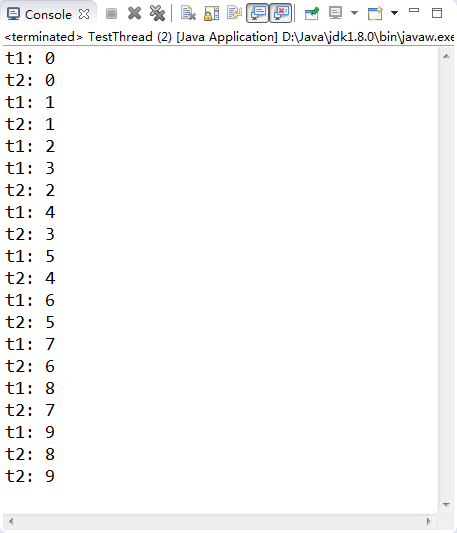转载地址:速学堂 https://www.sxt.cn/Java_jQuery_in_action/eleven-inheritthread.html
1. 通过继承Thread类实现多线程
继承Thread类实现多线程的步骤:
1. 在Java中负责实现线程功能的类是java.lang.Thread 类。
2. 可以通过创建 Thread的实例来创建新的线程。
3. 每个线程都是通过某个特定的Thread对象所对应的方法run( )来完成其操作的,方法run( )称为线程体。
4. 通过调用Thread类的start()方法来启动一个线程。
通过继承Thread类实现多线程
public class TestThread extends Thread {//自定义类继承Thread类 //run()方法里是线程体 public void run() { for (int i = 0; i < 10; i++) { System.out.println(this.getName() + ":" + i);//getName()方法是返回线程名称 } } public static void main(String[] args) { TestThread thread1 = new TestThread();//创建线程对象 thread1.start();//启动线程 TestThread thread2 = new TestThread(); thread2.start(); } }
此种方式的缺点:如果我们的类已经继承了一个类(如小程序必须继承自 Applet 类),则无法再继承 Thread 类。
2 通过Runnable接口实现多线程
在开发中,我们应用更多的是通过Runnable接口实现多线程。这种方式克服了上面实现线程类的缺点,即在实现Runnable接口的同时还可以继承某个类。所以实现Runnable接口的方式要通用一些。
public class TestThread2 implements Runnable {//自定义类实现Runnable接口; //run()方法里是线程体; public void run() { for (int i = 0; i < 10; i++) { System.out.println(Thread.currentThread().getName() + ":" + i); } } public static void main(String[] args) { //创建线程对象,把实现了Runnable接口的对象作为参数传入; Thread thread1 = new Thread(new TestThread2()); thread1.start();//启动线程; Thread thread2 = new Thread(new TestThread2()); thread2.start(); } }
线程状态
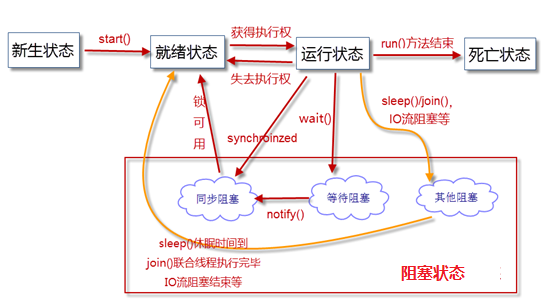
一个线程对象在它的生命周期内,需要经历5个状态。
▪ 新生状态(New)
用new关键字建立一个线程对象后,该线程对象就处于新生状态。处于新生状态的线程有自己的内存空间,通过调用start方法进入就绪状态。
▪ 就绪状态(Runnable)
处于就绪状态的线程已经具备了运行条件,但是还没有被分配到CPU,处于“线程就绪队列”,等待系统为其分配CPU。就绪状态并不是执行状态,当系统选定一个等待执行的Thread对象后,它就会进入执行状态。一旦获得CPU,线程就进入运行状态并自动调用自己的run方法。有4中原因会导致线程进入就绪状态:
1. 新建线程:调用start()方法,进入就绪状态;
2. 阻塞线程:阻塞解除,进入就绪状态;
3. 运行线程:调用yield()方法,直接进入就绪状态;
4. 运行线程:JVM将CPU资源从本线程切换到其他线程。
▪ 运行状态(Running)
在运行状态的线程执行自己run方法中的代码,直到调用其他方法而终止或等待某资源而阻塞或完成任务而死亡。如果在给定的时间片内没有执行结束,就会被系统给换下来回到就绪状态。也可能由于某些“导致阻塞的事件”而进入阻塞状态。
▪ 阻塞状态(Blocked)
阻塞指的是暂停一个线程的执行以等待某个条件发生(如某资源就绪)。有4种原因会导致阻塞:
1. 执行sleep(int millsecond)方法,使当前线程休眠,进入阻塞状态。当指定的时间到了后,线程进入就绪状态。
2. 执行wait()方法,使当前线程进入阻塞状态。当使用nofity()方法唤醒这个线程后,它进入就绪状态。
3. 线程运行时,某个操作进入阻塞状态,比如执行IO流操作(read()/write()方法本身就是阻塞的方法)。只有当引起该操作阻塞的原因消失后,线程进入就绪状态。
4. join()线程联合: 当某个线程等待另一个线程执行结束后,才能继续执行时,使用join()方法。
▪ 死亡状态(Terminated)
死亡状态是线程生命周期中的最后一个阶段。线程死亡的原因有两个。一个是正常运行的线程完成了它run()方法内的全部工作; 另一个是线程被强制终止,如通过执行stop()或destroy()方法来终止一个线程(注:stop()/destroy()方法已经被JDK废弃,不推荐使用)。
当一个线程进入死亡状态以后,就不能再回到其它状态了。
终止线程的典型方式
终止线程我们一般不使用JDK提供的stop()/destroy()方法(它们本身也被JDK废弃了)。通常的做法是提供一个boolean型的终止变量,当这个变量置为false,则终止线程的运行
public class TestThreadCiycle implements Runnable { String name; boolean live = true;// 标记变量,表示线程是否可中止; public TestThreadCiycle(String name) { super(); this.name = name; } public void run() { int i = 0; //当live的值是true时,继续线程体;false则结束循环,继而终止线程体; while (live) { System.out.println(name + (i++)); } } public void terminate() { live = false; } public static void main(String[] args) { TestThreadCiycle ttc = new TestThreadCiycle("线程A:"); Thread t1 = new Thread(ttc);// 新生状态 t1.start();// 就绪状态 for (int i = 0; i < 100; i++) { System.out.println("主线程" + i); } ttc.terminate(); System.out.println("ttc stop!"); } }
暂停线程执行sleep/yield
暂停线程执行常用的方法有sleep()和yield()方法,这两个方法的区别是:
1. sleep()方法:可以让正在运行的线程进入阻塞状态,直到休眠时间满了,进入就绪状态。
2. yield()方法:可以让正在运行的线程直接进入就绪状态,让出CPU的使用权。
暂停线程的方法-sleep()
public class TestThreadState { public static void main(String[] args) { StateThread thread1 = new StateThread(); thread1.start(); StateThread thread2 = new StateThread(); thread2.start(); } } //使用继承方式实现多线程 class StateThread extends Thread { public void run() { for (int i = 0; i < 100; i++) { System.out.println(this.getName() + ":" + i); try { Thread.sleep(2000);//调用线程的sleep()方法; } catch (InterruptedException e) { e.printStackTrace(); } } } }
执行结果如图所示(注:以下图示只是部分结果,运行时可以感受到每条结果输出之前的延迟,是Thread.sleep(2000)语句在起作用):

暂停线程的方法-yield()
public class TestThreadState { public static void main(String[] args) { StateThread thread1 = new StateThread(); thread1.start(); StateThread thread2 = new StateThread(); thread2.start(); } } //使用继承方式实现多线程 class StateThread extends Thread { public void run() { for (int i = 0; i < 100; i++) { System.out.println(this.getName() + ":" + i); Thread.yield();//调用线程的yield()方法; } } }
执行结果如图所示(注:以下图示只是部分结果,可以引起线程切换,但运行时没有明显延迟):
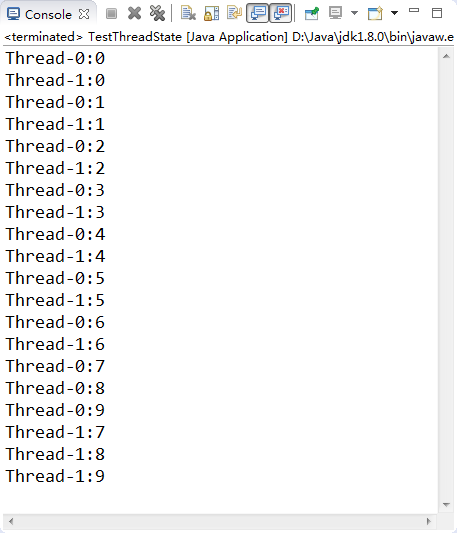
线程的联合join()
线程A在运行期间,可以调用线程B的join()方法,让线程B和线程A联合。这样,线程A就必须等待线程B执行完毕后,才能继续执行。如下面示例中,“爸爸线程”要抽烟,于是联合了“儿子线程”去买烟,必须等待“儿子线程”买烟完毕,“爸爸线程”才能继续抽烟。
public class TestThreadState { public static void main(String[] args) { System.out.println("爸爸和儿子买烟故事"); Thread father = new Thread(new FatherThread()); father.start(); } } class FatherThread implements Runnable { public void run() { System.out.println("爸爸想抽烟,发现烟抽完了"); System.out.println("爸爸让儿子去买包红塔山"); Thread son = new Thread(new SonThread()); son.start(); System.out.println("爸爸等儿子买烟回来"); try { son.join(); } catch (InterruptedException e) { e.printStackTrace(); System.out.println("爸爸出门去找儿子跑哪去了"); // 结束JVM。如果是0则表示正常结束;如果是非0则表示非正常结束 System.exit(1); } System.out.println("爸爸高兴的接过烟开始抽,并把零钱给了儿子"); } } class SonThread implements Runnable { public void run() { System.out.println("儿子出门去买烟"); System.out.println("儿子买烟需要10分钟"); try { for (int i = 1; i <= 10; i++) { System.out.println("第" + i + "分钟"); Thread.sleep(1000); } } catch (InterruptedException e) { e.printStackTrace(); } System.out.println("儿子买烟回来了"); } }
执行结果如图:
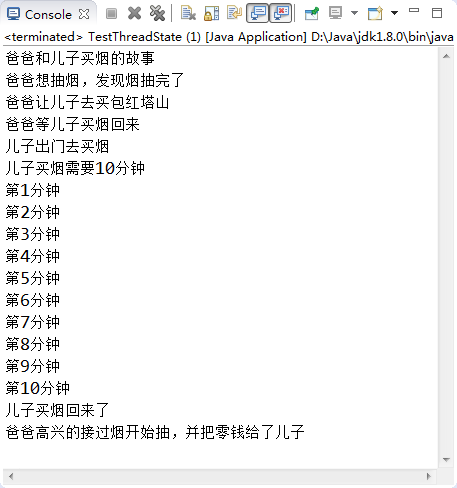
获取线程基本信息的方法

线程的常用方法一
public class TestThread { public static void main(String[] argc) throws Exception { Runnable r = new MyThread(); Thread t = new Thread(r, "Name test");//定义线程对象,并传入参数; t.start();//启动线程; System.out.println("name is: " + t.getName());//输出线程名称; Thread.currentThread().sleep(5000);//线程暂停5分钟; System.out.println(t.isAlive());//判断线程还在运行吗? System.out.println("over!"); } } class MyThread implements Runnable { //线程体; public void run() { for (int i = 0; i < 10; i++) System.out.println(i); } }
执行结果:
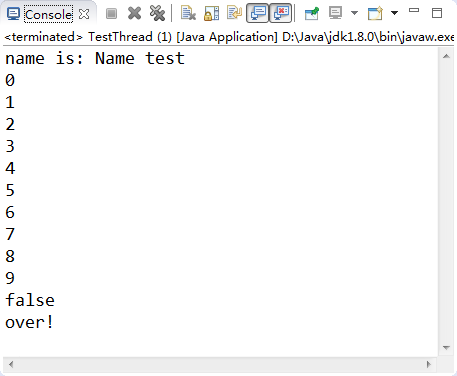
线程的优先级
1. 处于就绪状态的线程,会进入“就绪队列”等待JVM来挑选。
2. 线程的优先级用数字表示,范围从1到10,一个线程的缺省优先级是5。
3. 使用下列方法获得或设置线程对象的优先级。
int getPriority();
void setPriority(int newPriority);
注意:优先级低只是意味着获得调度的概率低。并不是绝对先调用优先级高的线程后调用优先级低的线程。
线程的常用方法二
public class TestThread { public static void main(String[] args) { Thread t1 = new Thread(new MyThread(), "t1"); Thread t2 = new Thread(new MyThread(), "t2"); t1.setPriority(1); t2.setPriority(10); t1.start(); t2.start(); } } class MyThread extends Thread { public void run() { for (int i = 0; i < 10; i++) { System.out.println(Thread.currentThread().getName() + ": " + i); } } }
执行结果:
